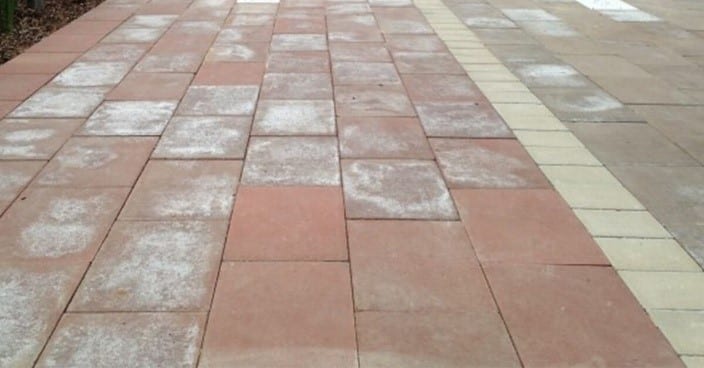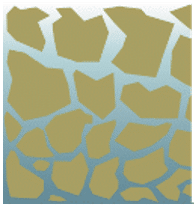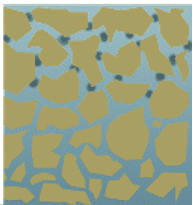EFFLORESCENCE PREVENTION ON PAVERS
INTRODUCTION
Efflorescence is a crystalline deposit that usually appears on the surfaces of bricks, masonry or concrete and is visible to the naked eye. Aesthetically it takes the appearance of a white powdery/crusty substance that detracts from the appearance of the substrate.
Limestone, concrete and brickwork (collectively called material) provide aesthetically pleasing structures. Typically, on new material, a white crystalline deposit will appear on its surface. These deposits are usually water-soluble salts referred to as efflorescence. Although aesthetically undesirable, efflorescence is usually not harmful to these materials.
This article describes the basic mechanisms of efflorescence, including possible sources of salts and water, providing a basic understanding of the phenomenon of efflorescence. This will help in understanding how Serveon’s sealant products prevent or minimize its occurrence.

Limestone: is a sedimentary rock composed largely of the mineral calcite (calcium carbonate: CaCO3) and lime or Calcium Oxide (CaO). It often has variable amounts of silica in it, as well as varying amounts of clay, silt, and sand. Limestone is subject to efflorescence.
Concrete/brickwork/mortar: Concrete is made using Portland cement, and cement is made from limestone using a process called calcination—where limestone is heated with other materials to 1450 degrees Celsius, resulting in a hard substance called clinker. The clinker is then ground into a fine powder to make cement. Any material containing Portland cement can result in efflorescence.
CAUSES OF EFFLORESCENCE
There are many aspects of efflorescence, some complicated. It is difficult to predict if and when any will appear. Simply stated however, efflorescence occurs when water containing dissolved salts is brought to the surface, the water evaporates, and the salts are left on the surface. The salt solutions may migrate across surfaces of the material, between the mortar and material, or through the pores of the mortar or the material. Water soluble salts are generally characterized by the presence of calcium sulfate, calcium carbonate and sodium chloride.
There are certain simultaneous conditions that must exist in order for efflorescence to occur:
- Soluble salts must be present within or in contact with the material. These salts may be present in mortar ingredients, backing materials, trim, adjacent soil, etc.
- A source of water must be in contact with the salts for a period of time sufficient to dissolve them.
- A pore/capillary structure must be present in the material that allows the migration of salt solutions to the surface or other locations where evaporation of water can occur. A driving force, such as a temperature or humidity gradient (evaporation) or in severe cases, hydrostatic pressure, directs moisture through the pore structure.
- If any of these conditions are eliminated, efflorescence will not occur.
THE CHEMISTRY
Concrete is made using cement, and cement is made from limestone. Consequently, all concrete paving’s contain a quantity of lime, or Calcium Oxide (CaO) as does limestone. Calcium Oxide is water-soluble. It dissolves to form Calcium Hydroxide. The soluble Calcium Hydroxide can migrate to the surface of the material, whereupon it has the opportunity to react with Carbon Dioxide (CO2) in the atmosphere and water to form Calcium Carbonate, which is not soluble.
The carbonation of the Calcium Hydroxide results in the insoluble Calcium Carbonate being deposited on the surface of the material while the water simply evaporates away. It is the Calcium Carbonate that forms the white deposit that is the most visible indicator of ongoing efflorescence.
While the Calcium Carbonate is insoluble in water, it is not permanent and gradually reacts with more Carbon Dioxide and more water to form Calcium Hydrogen Carbonate, more commonly known as Calcium Bicarbonate, which is soluble.
The problem is that this transition from insoluble to soluble is much slower than the preceding transition from soluble to insoluble, so there is a ‘stockpiling’ of excess insoluble material, which is the white deposit seen on the surface of most pavers.
SALTS/WATER/CARBON DIOXIDE
While the vast majority of the Calcium Oxide (what causes efflorescence) will come from the material itself, it may also be present in the laying course material (what a paver is laid on). This is especially true where a mortar, concrete or other cement-bound bed is used. Similarly, water comes not only from precipitation, that is, rain and snow, but also from the ground beneath the material, from the atmosphere (as dew), from washing the car, or from watering the lawn, as well as being a vital component of the original material as is the case with concrete and pavers. The Carbon Dioxide is ever-present in the natural atmosphere, but there may be environments where levels of CO2 are higher or lower than normal due to local natural phenomena such as vegetation.
HOW DOES EFFLORESCENCE DISAPPEAR?
As mentioned in the previous paragraphs, the white bloom is gradually converted to a soluble compound that is usually washed away by the weather or pressure washed. However, there are other factors that act to reduce or remove the visual impact of efflorescence.
At a point, the amount of salts in the material are used up over time. With no salts there is no efflorescence. Finally, the tiny pores and voids within the material matrix through which the soluble Calcium Hydroxide is transported eventually can become plugged with deposits of the insoluble Calcium Carbonate. This action effectively blocks the escape route for the Calcium Hydroxide and ‘locks in’ any further reactions, forcing them to take place below the surface and, conveniently, out of sight. Blocking the capillaries that allow the calcium hydroxide to be transported to the surface is the key to preventing efflorescence.
PREVENTING EFFLORESCENCE
There is a wide range of different sealants, but for the purposes of this discussion, they can be divided into two types: those that form a ‘film’ on the surface, normally acrylic based sealants, and those that penetrate and form a more considerable barrier extending several millimeters into the material. Film forming sealants are generally ineffective against efflorescence as the process continues and the carbonate material is deposited beneath the thin layer of sealant. Penetrating sealants can block the pores of the material near the surface, thereby limiting the absorption of water and carbon dioxide, and the egress of calcium carbonate, which remains trapped within the material.
We believe Serveon’s sealants are the most effective sealants available at preventing efflorescence. This is because the unique formulations are proven to both penetrate and block the pores and capillary routes taken by the Calcium Hydroxide to reach the surface while at the same time, preventing water being able to be absorbed into the material. Restricting the amount of water limits or prevents the ability of the salts to be dissolved. Undissolved salts cannot create efflorescence.

UNTREATED/UNBLOCKED

TREATED/BLOCKED
Serveon has three water-based sealants that prevent efflorescence. NS800, RS800 and NS200. Of the three, NS800 is the most effective. All three of these sealants do not form strong bonds with sanded/unsanded grout and mortar.
Treating the surface of the material and any adjacent mortar or grout will normally prevent the occurrence of efflorescence. Treating all sides of the material is the most effective prevention. Untreated mortar or grout where also present is a source of efflorescence and must also be treated.
Material, as used here, means “porous”, cement, limestone, etc. Application, however, can depend on the surface: honed, polished or natural will absorb differently. In all cases it means saturation application(s). Porous material when viewed closeup contains large areas to be covered and will normally absorb a lot of sealant. The more sealant applied, the more effective the blocking becomes. Please see the applicable product Data Sheet and Application Guide for specific guidelines.
PROBLEMS IN PREVENTING EFFLORESCENCE
Of the three conditions that cause efflorescence, moisture is the only one that can be controlled. Recurrent efflorescence indicates a chronic moisture problem. Steps should always be taken to minimize the amount of non-precipitation water. Where severe water issues exist, it can create hydrostatic pressure that can rupture the blocking bonds. There are no short cuts to preventing efflorescence. When proper drainage is not present it can cause efflorescence issues, although reduced, even in sealed materials until the salt source is used up or the water source is eliminated.
REMOVING EFFLORESCENCE
Efflorescence can be removed with either of Serveon’s cleaners, CL500 or CL750. In both cases apply the cleaner, let sit for 1-2 minutes, while sitting agitate with a stiff plastic bristle brush then thoroughly rinse with water. With some stubborn deposits, the procedure may have to be repeated.